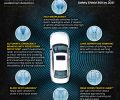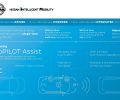- Nissan Safety Shield 360 supports the Nissan Intelligent Mobility vision to redefine how cars are driven, powered and integrated into society.
- Nissan Safety Shield 360, a suite of active safety technologies, will first be available on the all-new 2019 Altima and 2019 Rogue – both on sale this fall
- Nissan Safety Shield 360 to be standard on one million new vehicles sold annually in the U.S. by 2021
- The suite of advanced driver-assist systems includes Automatic Emergency Braking with Pedestrian Detection1, Blind Spot Warning2, Rear Cross Traffic Alert3, Lane Departure Warning4, High Beam Assist and Rear Automatic Braking5
NASHVILLE, Tenn. – Nissan is introducing Safety Shield 360, a suite of six advanced active safety and driver-assist technologies, as standard equipment on all of its top-selling models by 2021, representing more than one million vehicles annually.
“Our philosophy is to bring Nissan Intelligent Mobility technologies to market in our most popular and affordable vehicles,” said Denis Le Vot, chairman, Nissan North America. “Safety Shield 360 combines six advanced systems to give models like Altima and Rogue a class-leading package of technologies that can improve safety and the overall driving experience for Nissan owners.”
According to the Insurance Institute for Highway Safety (IIHS), cross traffic alert reduces crashes by 22 percent; the combination of rearview cameras and sensors reduces crashes by 42 percent; and adding rear emergency braking reduces backing crashes by 78 percent compared with vehicles with none of these features.
Nissan Safety Shield 360, which includes front, side and rear sensing technologies – will first be introduced as standard equipment on SV and SL grades of the upcoming 2019 Rogue, 2019 Rogue Sport and the all-new 2019 Altima, which all go on sale at Nissan dealers in fall 2018.
Nissan Safety Shield 360 suite includes six key advanced systems:
| Front |
|
| Side |
|
| Rear |
|
Other Key Nissan Intelligent Mobility Features
Safety Shield 360 is the latest development of Nissan Intelligent Mobility, the company’s vision for changing how cars are driven, powered and integrated into society.
Another key component of Nissan Intelligent Mobility is ProPILOT Assist6, which will be available on the all-new 2019 Altima. ProPILOT Assist eases driver workload by reducing the amount of driver acceleration, steering and braking input under certain driving conditions, during single-lane highway driving. ProPILOT Assist is the foundation for automated vehicles of the future, helping drivers stay centered in the lane, navigate stop-and-go traffic, maintain a set vehicle speed and maintain a set distance to the vehicle ahead. Currently, Nissan offers ProPILOT Assist on the 2018 Rogue and the all-electric 2018 LEAF.
Nissan ProPILOT Assist technology reduces the hassle of stop-and-go highway driving, ready for U.S. launch
- Nissan enhances the driving experience by introducing technologies to make vehicles more intelligent, exciting and attainable partners
- New ProPILOT Assist hands-on-wheel technology paves the way to the next level of autonomous driving
- Unique Nissan Intelligent Mobility approach makes technology easy and intuitive – ProPILOT Assist features “two-button” activation
FARMINGTON HILLS, Mich. – Earlier this week, for the first time on public roads in the U.S., Nissan put media behind the wheel to experience its ProPILOT Assist technology, which will be available to customers later this year. ProPILOT Assist reduces the hassle of stop-and-go driving by helping control acceleration, braking and steering during single-lane highway driving.
The ProPILOT Assist system – revealed at Nissan Technical Center North America (NTCNA) in Michigan, tuned specifically for U.S. roads and drivers – underwent more than 50,000 miles of development on roads across the United States. ProPILOT Assist combines Steering Assist and Intelligent Cruise Control for use in both heavy and flowing traffic situations. It is a “hands-on” driver assist system rather than a “self-driving” feature.
Nissan ProPILOT Assist
“Nissan is a technology pioneer and ProPILOT Assist sets a strong, consumer-focused foundation for fully autonomous vehicles of the future,” said Takeshi Yamaguchi, senior vice president, Research and Development, Nissan Technical Center North America, Nissan North America, Inc.
Nissan has plans to extend this technology to more models in Europe, Japan, China and the United States – with 10 models to be launched by 2020 by the Renault-Nissan Alliance.
How ProPILOT Assist Works
Tuned specifically for U.S. roads, ProPILOT Assist is designed to be more intuitive and user-friendly compared to other driver-assist technologies. It can potentially help lessen driver fatigue and create a more confident driving experience – especially for drivers who experience heavy highway traffic on a daily basis.
ProPILOT Assist uses a forward-facing camera, forward-facing radar, sensors and electronic control module to help the driver stay in the center of the driving lane and to maintain vehicle speed (set by the driver) or help maintain a gap to the preceding vehicle if the vehicle speed drops below the driver-set speed. It also can slow the vehicle to a complete stop and holds the vehicle during traffic jam conditions.
While providing steering assist, reducing the need for constant small steering adjustments, the driver’s hands must be on the steering wheel at all times. Hands-on detection is provided by the system’s steering torque sensor. If the driver only grips the steering system with a light touch, the warning system may activate, alerting the driver to apply more pressure or a tighter grip on the steering wheel.
Steering assist is cancelled in inclement weather if the windshield wipers are in the low or high position (if lane lines can be detected, the system can remain active when the wipers are in the intermittent mode or if the mist function is activated).
The driver’s input always takes priority, overriding the system when the steering wheel is turned or the turn signal is operated (steering assistance goes into a temporary standby mode). The system also goes into temporary standby mode when the accelerator pedal is pressed. And, the system’s Intelligent Cruise Control and lane keep assistance are both cancelled when the brakes are applied.
“ProPILOT Assist has the ability to track curving lanes, helping the driver stay centered in the lane as well as adjusting for various traffic flow conditions,” said Yamaguchi. “However, just as non-autonomous vehicles today, ProPILOT Assist requires the driver to remain engaged in the task of driving at all times – though the technology can reduce driver fatigue and increase driving enjoyment.”
About ProPILOT Assist
Nissan’s new ProPILOT Assist eases driver workload by reducing the amount of driver acceleration, steering and braking input under certain driving conditions. To activate the system, the driver simply pushes the blue ProPILOT Assist ON button, which is integrated into the right-side steering wheel spoke. Step two is to set the Intelligent Cruise Control when the desired speed is reached, as with a normal advanced cruise control system.
When lane markers are consistently detected, steering assist engages and the steering wheel/lane marker icons on the instrument panel turn green. Both right and left hand markers need to be detected by the front camera. Steering assist will engage or disengage depending on the visibility or presence of lane markers, though the Intelligent Cruise Control will remain active.
If the vehicle comes to a complete stop in a traffic jam situation for more than three seconds, the driver just presses the resume button or taps the accelerator pedal to begin moving again.
“ProPILOT Assist functionally enhances the ICC system, including stop, hold and start, while the steering assist’s lane centering helps keep the vehicle in the center of the lane,” added Yamaguchi. “Drivers who have experienced ProPILOT Assist always remark about the difference it makes, not realizing how many acceleration, steering and braking inputs they make under normal driving – and how much more enjoyable it is to have ProPILOT Assist help take care of it for them.”
Nissan Intelligent Mobility –building on global progress
As the world is facing serious challenges such as climate change, traffic congestion, road fatalities and increasing air pollution, Nissan is committed to addressing these challenges by making transportation safer, smarter, and more enjoyable. The ultimate goal is achieving zero-emissions and zero-fatalities on the road. Nissan Intelligent Mobility is the roadmap to achieve it.
Nissan Intelligent Mobility is not about removing humans from the driving experience. Instead, it is about building a better future for Nissan customers where cars are their partners, and where drivers are more confident and more connected.
Nissan Intelligent Mobility encompasses three core areas of innovation, not solely focused on autonomous drive:
Nissan Intelligent Driving helps to give customers more confidence through enhanced safety, control, and comfort. Driver Assist technologies can already be found in Nissan vehicles today, including the Japanese market Nissan Serena, the first model produced to feature ProPILOT Assist technology. Serena will be joined by the European model Qashqai in fall 2017.
Nissan Intelligent Power makes driving more exciting for customers by continuing to reduce emissions and increase fuel economy. Nissan is committed to a holistic approach to achieving zero-emission mobility by making internal combustion engines more efficient and putting more advanced technologies into our electric vehicles.
Nissan Intelligent Integration keeps customers more connected by conveniently linking Nissan cars to the wider society. Nissan is helping to shape a sustainable ecosystem enabling cars to interact with people, other cars and road infrastructure. This approach will eventually lead to remote vehicle operation, reduced traffic jams, more efficient car-sharing, and improved energy management.
- AEB cannot prevent accidents due to carelessness or dangerous driving techniques. It may not provide warning or braking in certain conditions. Speed limitations apply.
- BSW is not a substitute for proper lane change procedures. The system will not prevent contact with other vehicles or accidents. It may not detect every vehicle or object around you.
- Rear Cross Traffic Alert may not detect all vehicles. See Owner’s Manual for safety information.
- Lane Departure Warning only operates when lane markers can be detected. See Owner’s Manual for safety information.
- Rear Automatic Braking cannot prevent all collisions and may not provide warning or braking in all conditions. Driver should always turn and check surroundings before driving. See Owner’s Manual for safety information.
- ProPILOT Assist: It is the driver’s responsibility to remain alert with hands on steering wheel, keeping a look out for other vehicles and pedestrians at all times.


